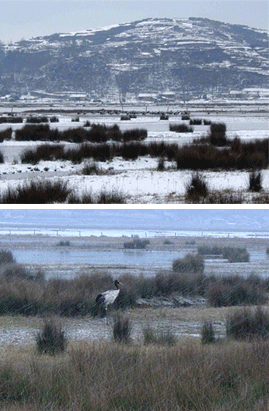 | In this Section: | |  | In the Spotlight |  | News |  |
List of "In the Spotlight" Features
Cranes Take Flight
 Signals of Spring students often ask about how scientists go about tagging and tracking animals. It is not always an easy task as scientists must contend with weather conditions, transportation issues, and uncooperative animals! Below, Dr. Li Fengshan of the International Crane Foundation shares field notes about tagging one of the birds. Signals of Spring students often ask about how scientists go about tagging and tracking animals. It is not always an easy task as scientists must contend with weather conditions, transportation issues, and uncooperative animals! Below, Dr. Li Fengshan of the International Crane Foundation shares field notes about tagging one of the birds.
 |
PTT #64311 (Sera) |
 |  |
 |
Release site: Bojiwan, Cao Hai National Nature Reserve
Time and Date: 17:30, Feb 28, 2006 (Beijing time)
Color band combination: Left leg Yellow over Red
Age: Adult
Body weight: 6.25kg
Body length:117 cm
Social status: Observed with a group of ten Black-necked Cranes
 March 1, 2006
March 1, 2006
This morning, we went out to look for #64311 at Bojiwan on the east side of the Cao Hai lake. Since Cao Hai has been having freezing rain for the last two days and the road conditions are very bad, we waited until 9:30 am to go out to search for the bird. The road from Weining town [the largest city within the Cao Hai Nature Reserve] to Yunnan was still closed to public transportation due to bad road conditions. We drove a Jeep and got to Bojiwan without any problems. Because of the cold weather, most of the cranes roosting at Bojiwan were still at the roost site, looking and preening. We saw about 130 Black-necked Cranes. The lake water was covered with thin ice. It took us a long time to find #64311, since this bird stayed behind a large group of cranes, but appeared to be moving normally. At one point, we saw this bird being chased away by a larger crane.
This afternoon, we went to Bojiwan and the area where #64311 was captured, but we did not see this bird. However, we saw a very large flock of other waterbirds, including about 400 mallards, 400 spot-billed ducks, 300 common teal, 30 bar-headed geese, 10 pin-tails, and five ruddy shelducks. We only saw two Eurasian Cranes.
Attached are two pictures. The first is of #64311s release and roost site and the second is of #64311 just after being released.
|
|





